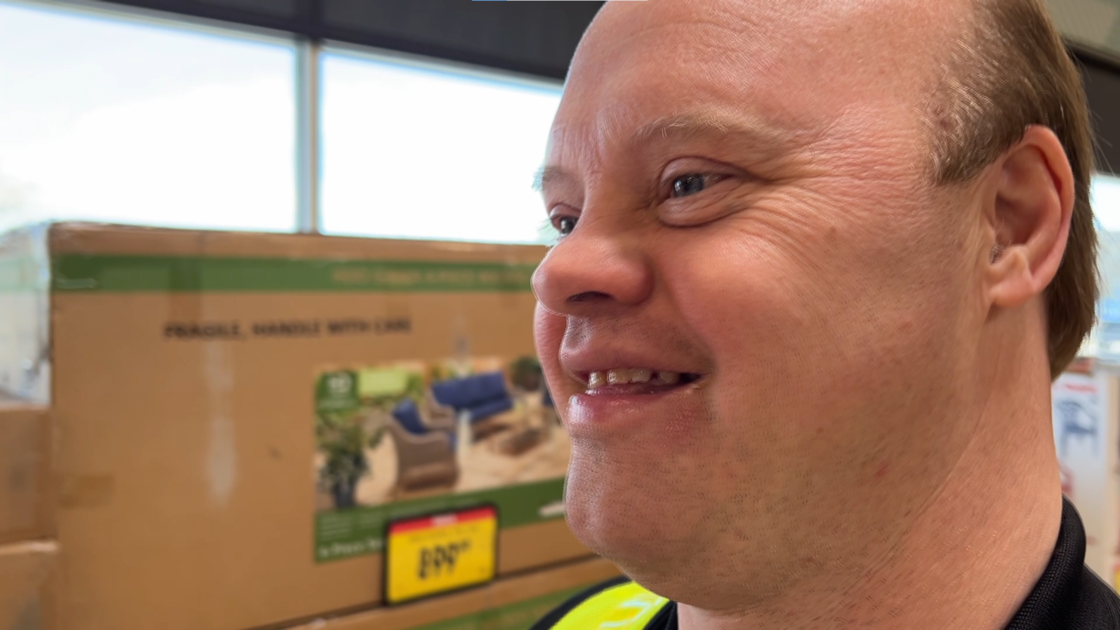A Day With a Home Care Physical Therapist
Anne Osmer Reporting
When I first meet Mark Heitchue, physical therapist for Residential Home Health, I'm struck by his height. He's really tall. Six foot five, to be exact. He's also sturdily built, trim but strong. I'm also struck by how I immediately feel comfortable with him. Despite his size, there's something about Mark that puts a person at ease.
I meet him at Residential Home Health's office in Madison Heights. He takes me for a quick tour, explaining the various functions: intake, scheduling, supplies, administrative. He says hello to staff people as we walk through the office. In his hand he holds supplies for his visits today: rubber bands of various colors. They're wider and longer than regular rubber bands, and later I'll learn they're used to help strengthen weak areas of patients' bodies.
In the car, Mark explains how his schedule works. He's required to see about six patients a day, but often he sees one or two more. Usually he sees the same patient twice a week, but if they've had a hip or total knee replacement he'll see them three to four times a week for a two-week period, at which point they begin outpatient therapy.
One question leads to another – I have lots of questions for him – and I realize that in addition to being very tall, Mark is extremely patient, a quality that is a great asset in his work. As a home health care physical therapist, he helps people recover from surgery, injuries and other physical challenges, and listening to his patients – their complaints, fears and aspirations – is an important part of what he does.
The first patient we visit is a 73-year-old woman, Janet*, who fell in her kitchen, breaking her femur in four places. Following surgery, she suffered from complications and ended up back in the hospital for four months. She's been back home now since mid-September. She lives alone but has a daughter and son nearby. This is her last visit with Mark.
Janet is waiting for us when we arrive. She's an attractive woman with white hair, a slight build and a wide smile. She wears black-rimmed glasses and tasteful, wine-colored lipstick. Mark jokes about how great she looks – when she first began physical therapy it was all she could do to get out of bed; she answered the door in her bathrobe. She laughs. Looking at her I can see she's a person who takes care of herself. Clearly, she's come a long way.
Janet asks me to make myself comfortable and I take a seat on the couch. Her home is small and cozy. Two cabinets in the living room hold religious figurines, as well as a collection of pig souvenirs. (A trip to the bathroom confirms Janet's affection for pig memorabilia, where I find cute pig towels and other pig tchotchkes.) A treadmill and stationary bike crowd one end of the room.
Mark asks Janet how she's been doing. Is she in any pain? He gauges the strength in her legs by testing their resistance. He remarks that her right leg has made a lot of progress but is still weaker than the left. He asks her to stand on one foot, then the other, testing her balance. Balance can be very difficult if a leg is weak or recovering, he explains, but having good balance is one of the things that can keep a person from future injury.
As they map out Janet's future plan for recovery, since Mark will – hopefully – not see her again, they have a conversation about the treadmill. Janet's son moved it into the house to aid in her therapy, but it's been problematic. It's a manual treadmill and not easy to use. Mark and Janet test it out again before deciding whether Janet should continue using it. She gets on it and tries to walk, but can't get it going. She tries again, grimacing, but it doesn't move. She and Mark decide that at this point the treadmill is more of a danger than a help, and Janet agrees to have her son remove it. Mark looks for a new place in the room to anchor the red rubber band used to exercise Janet's leg; previously it was placed around the treadmill.
This is where it gets interesting, Mark explains. He goes on to say that creativity plays a big part in every patient's therapy. "You've got to be as creative as possible for this setting," he says. "Both the physical therapist and the patient have to be creative." They settle on a chair that's the right height for the rubber band exercise.
Janet has a request. She used to cut her toenails on the floor in front of the couch. Now she uses a step stool in front of the armchair, but she likes the floor better. Can they try that? Mark explains to me that getting up from the floor is one of the most difficult tasks for a person with limited mobility.
He looks at the couch, assessing the situation. He gets down on the floor and shows Janet how to get up from the floor and then asks her to try. She can't get up, and Mark makes some adjustments and suggestions. She continues to struggle and gives up, laughing. "Well, I guess I'll just use the step stool, then!" Mark agrees that's probably the best solution for now. (Later in the car he tells me that the hardest thing about his job is having to watch his patients struggle. "Because I'm not going to be there every time," he says.)
Earlier in her physical therapy, they worked on other transition movements, Mark and Janet tell me. They worked in the kitchen, with Mark giving directions to Janet, mimicking real-life kitchen activities. She got out pots and pans, put water on the stove, made coffee; all things many of us take for granted, but are difficult for someone recovering from surgery or another condition. Mark was able to help Janet get reacquainted with every-day activities while assessing her for areas to work on – but without doing too much too soon. Keeping his patients safe is key to Mark's work.
To help with that, Mark assesses each home for safety. This is a critical function of home health care professionals, he tells me. Mark talks to his patients, explaining how important safety is to maintaining their independence. Often he'll advise a patient to clean up clutter, remove boxes and other debris from the floor that might be tripping hazards. "I try to guide them and move them in a direction of safety," he says. He writes out instructions for them if necessary.
Mark leaves Janet with a list of potential outpatient physical therapy clinics and a warm hug. His huge frame dwarfs her small one as they embrace. He says he'll miss her, but he's glad she's moving on.
On the way to our next appointment I ask Mark about his background. Mark is new to home care physical therapy, he tells me; he started with Residential Home Health on Sept. 1, 2007. Prior to that he worked at an outpatient clinic. He decided to make the move to home care for several reasons: flexibility and independence – with four kids, he's juggling work and family; the pay is slightly better; but mostly he felt he could help more by serving an older population. When his father was sick at home he began to see a huge need for helping older people. "They're lonely, they need help, and I felt as if I could help," he says. We're faced with a huge challenge going forward, he says, caring for "people with worse health problems but living longer." Keeping them home and safe will be difficult.
He goes on to say that his work with home care is very satisfying. He likes Residential Home Health. "This company is in for the long haul," he says. He says RHH works hard to try and hire good people. But his biggest satisfaction comes from his patients. He's particularly pleased when he helps a patient meet or exceed goals. He tells me about one patient with Parkinson's recovering from falling and breaking his hip. By the time Mark saw him he'd been in therapy for a month. He'd been told he would be in a wheelchair, most likely for the rest of his life. The patient didn't want that and was willing to work with Mark to walk again. Mark pushed the patient hard, he says, and they not only reached the patient's goals, but exceeded them. He now walks without a walker or cane. "He told me, 'You're doing more for me than anyone's done in the past,'" Mark says.
I ask him how home care is different from working in a clinic, besides working with an older population. Mark says that with outpatient therapy the patient is in your space. With home care, you're in their space. It's a different dynamic. You need to respect that, he says, and you need to assess each home for safety as well as opportunities for therapy. You have to be respectful and creative.
I get to see an example of this philosophy with the next patient, Paul*, who lives in an apartment complex with stairs and long balconies – perfect for exercising his hips following a hip replacement. We go up three flights of stairs and pause at each landing, Mark asking questions along the way, making sure Paul can handle it. Paul is all enthusiasm – he wants to push harder, and Mark needs to make sure they're not doing too much. He's impressed, though, with the progress he's made from just a few days ago. A motivated customer, Paul tells Mark he's been doing his exercises religiously. His goal is to walk without a limp as soon as possible.
Mark likes this kind of patient, he tells me later. Figuring out goals and a plan with a patient and reaching those goals is very satisfying. "You paint a picture," he says. "Here's where we are now. Here's where we'll go. And you follow through."
Patients with a positive outlook tend to get better faster, he says. That's one of the reasons he dislikes the Medicare-mandated question, "Are you in any pain?"
It's a negative question, Mark says. One of the things that he does, and that people training to be physical therapists learn in their psychology classes, is to use the power of positive suggestion. Instead of asking, "How are you today?" he'll ask, "So you're feeling good today?" This gives the patient the opportunity to see if they might, actually, be feeling good instead of bad. It puts the possibility in their mind. But Mark always finds a way to work in the less-positive Medicare question, verbatim, since it's required.
As I leave Mark I tell him I'm no expert, but I think he's a great physical therapist. He thanks me and says, "I'm only as good as the patient. Patients that do what you ask them to do, they get better."
*For purposes of confidentiality, patient names have been changed.
© 2010 WWJ Radio, All Rights Reserved.



